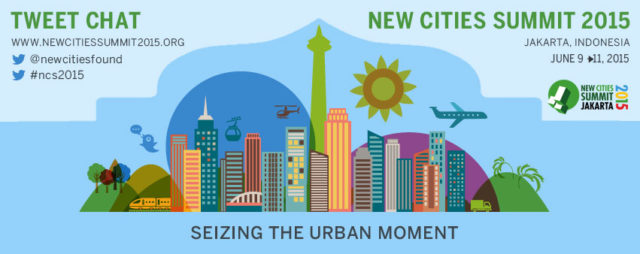Tweet Chat Recap: Animating our Public Spaces
mars 27, 2015 — Uncategorized
Cities have capability of providing something for everybody when they are created by everybody. Public space is where this happens – Global Cultural Districts Network – @GCDNet
On March 25, we hosted our second Tweet chat in the run-up to our New Cities Summit in Jakarta. The topic this month was Animating our Public Spaces.

Animating our Public Spaces: Tweet chat Highlights
14 international featured guests took part in a public discussion on Twitter on the possibilities of public space within cities.
Why is public space crucial to cities?
Public spaces are essential for the development of a more connected society where people could share their ideas.@NenaDodi
Public space is the connective tissue uniting neighbors regardless of their demographics.@ccuellar
Public space mediates our experience of cites, and thereby determines the city. If it doesn’t working we need to shape it ourselves. @LookAtYourCity
How can city governors, planners and citizens collaborate more creatively to animate public space?
Step 1 is identifying how citizens would LIKE to use public space. @eddo_likes_you
Delegate to citizens the animation of public spaces on short periods of time. @quartierlibr
Governors + planners should not tie funding for street improvements only to vehicular traffic if they want public spaces animated. @ccuellar
Has social networking removed the need for physical public space?
Social media can never replace the pleasure of being in a great park. @Genie_Birch
Perhaps the question is how social networking can be facilitated in public space – collectively?@Christianmcoop
Free wifi is certainly an amenity that would bring online users to public spaces – cities can tap into that!@victoria_okoye
Is the mall today’s central public space? What is the effect on urban communities?
Heavy rain and traffic make malls the most accessible space in some cities but their potential as public space remains limited. @sarinearslanian
Even where malls act as public space,we need to recognize the interests are primarily economic, not social. It’s a balancing act. @GCDNet
In China, ppl gather in malls for tai chi or dance. Means current public spaces not serving public needs.@eddo_likes_you
How could cities maximize space at different times of day and night?
Some private spaces during the day could be turned into public spaces at night.@quartierlibr
Defensible space: more people and surveillance means safer space. Occupied spaces are the safest See:http://goo.gl/d4bihD. @futurecapetown
By keeping space open day and night, by imagining creative areas, by offering secure space.@bergesdeseine
Host evening concerts/exhibits in public parks, provide space for street vendors and for reading/studying after work hours, etc.@sarinearslanian
Do you have examples of imaginative, effective use of public space in different cities?
Paris Berges de Seine : a new promenade along the Seine in the heart of Paris
#Bergesdeseine. @bergesdeseine
Infecting the City public art festival demystifying relationship between artist,audience and space. More:http://goo.gl/kU8dGx . @futurecapetown
Artist Jakob Fenger animates Superkilen park in Copenhagen w furniture to reflect the cultures of park-goershttp://bit.ly/1HCb4Hv. @GCDNet
Postmans park in London, small and intimate with plaques to ordinary people who died saving others – wonderful. @Christianmcoop
Jardin Atlantique above Paris Gare Montparnasse. Roof of train station = neighborhood park in dense urbanity.@eddo_likes_you
#ChaleWote street art festival in Accra: city’s first street fair, and legitimizes street as public space. @victoria_okoye
Featured guests included:
- PennIUR, The Penn Institute for Urban Research, @PennIUR
- Thibaut Thomas, Communication and digital strategies consultant, @thibautthomas
- Genie Birch, Professor, PennIUR, @Genie_Birch
- Christian Coop, Design Director at NBBJ, @Christianmcoop
- Global Cultural Districts Network, @GCDNet
- Clement Berardi, Co-founder, Quartier Libre, @quartierlibr
- Berges de Seine, @bergesdeseine
- Future Cape Town, @futurecapetown
- GEPI, Global Entrepreneurs Program Indonesia, @GEPIndonesia
- Catherine Cuellar, CEO of the Dallas Arts District, @ccuellar
- Bernie Mitchell, Ouishare London, @BernieJMitchell
- Elena Giroli, Ouishare London, @NenaDodi
- Sarine Arslanian, Urban Researcher, @sarinearslanian
- Edward Meng, Impact KAEC Fellow, @eddo_likes_you
Thank you!
Thanks to all of our featured guests, and to the many others that joined in on Twitter. We hope you’ll join us again for our next Tweet chat session. For a full view of the conversation, check out our post on Storify.
To find out more about the New Cities Summit, visit newcitiessummit2015.org and follow #ncs2015 on Twitter.
